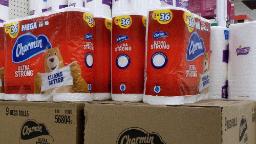
New York (CNN Business)Slimmed down toilet paper, fewer cookies in the bag, less conditioner in squeeze tubes.
The changes are subtle and might elude less demanding buyers. But retail industry experts say more consumer products could shrink in size or quantity – or both – due to rising costs.
Record levels of inflation mean that households are paying more for everyday purchases and it is costing companies more to produce packaged items such as paper products, shampoos and food and beverage products.
Businesses can raise prices, and many do. Others charge the same price but offer less.
Product downsizing, also known as “shrinkflation,” is occurring in toilet paper, said Edgar Dworsky, a former Massachusetts assistant attorney general who is a consumer advocate and editor of the website ConsumerWorld.org.
“Reductions in workforces occur during periods of high inflation because companies that make everyday products are also paying more for raw materials, production and delivery costs,” said Dworsky, who has tracked how periods of high inflation affect consumer goods for three decades.
Dworsky said that downsizing of products is becoming more common, and he recently picked up several cases of brands discreetly downsizing their products.
For example, Procter & Gambles (PG) Charmin’s 18-count ultra-soft toilet paper now contains 244 double-ply sheets, down from the previous 264 double-ply sheets per roll. And the brand’s super mega rolls now show 366 sheets versus 396 sheets per roll previously.
“That amounts to losing about a roll and a half in the new 18-pack,” he said.
Dworsky noted that the large packs of toilet paper are now most commonly stocked in stores. “It’s almost impossible to find a four-pack,” he said.
Although he doesn’t track product prices, Dworsky said when it comes to downsizing, consumers end up either paying more for less of the product or the same price but for less of it.
“This does not mean that every Procter & Gamble toilet paper product will see a change. But I suspect there will be changes to more products coming,” he said, adding that he will have an upcoming report on other toilet paper brands.
In their recent conference call, Procter & Gamble executives acknowledged that the company is facing a “challenging cost environment” due to the ongoing impact of the pandemic on supply chains, a tight labor market and “remaining tight material availability.”
As a result, P&G said it is increasing prices for its retail customers for 10 product categories, including laundry detergent, dryer sheets, baby and feminine care products.
In an email to CNNBusiness, Procter & Gamble pointed out various reasons for the different sizes of its products and that retail prices are determined solely by retailers.
“Innovation has a cost element – adjusting the number per pack or the pack size is a way to reinvest in that innovation while maintaining a competitive price,” the company said.
P&G said it also adjusts product sizes for different retailers. So the buns may have shrunk in some stores, but not in others.
“For the same retailer, the assortment you find in a suburban location may differ from that in a smaller urban retail location – and in comparison to what can be found on a retailer’s website,” it said.
Why “shrinkflation” happens
The phenomenon of “shrinkflation” is nothing new. The practice is typically triggered when inflation spikes and the costs of businesses increase.
As costs increase, consumer goods manufacturers look for ways to offset the increases they pay for raw materials, transportation, labor, and other expenses. They either increase the prices of existing products or decrease the size of existing goods, increasing the price per unit of what you get.
These increases are passed through stores to buyers who buy products from consumer goods companies.
Other recent examples of scaled-down products that Dworsky noted were Keebler Cookies. He said the pack of Deluxe Chips with M&Ms has dropped to 9.75 from a previous 11.3 ounces per pack.
Shoppers have drawn his attention to new Gatorade bottles that hold smaller beverages — 28 fl oz down from 32 fl oz — and a change in packaging for Pantene conditioners to a slimmer squeeze tube that also holds two ounces less of the product.
“For consumer goods companies, raising prices for consumers is the last resort. That’s because in-store price increases are highly perceived by shoppers and can affect demand,” said Mark Cohen, director of retail studies and associate professor at Columbia University’s Business School.
Instead, companies are making subtle adjustments to products and packaging. “For consumers, this is sort of a nuisance…or a problem, depending on the product,” Cohen said. “I believe that inflation will continue for a while and we will see that such product adjustments will continue to take place.”
– CNN’s Nathaniel Meyersohn contributed to this story
Add Comment